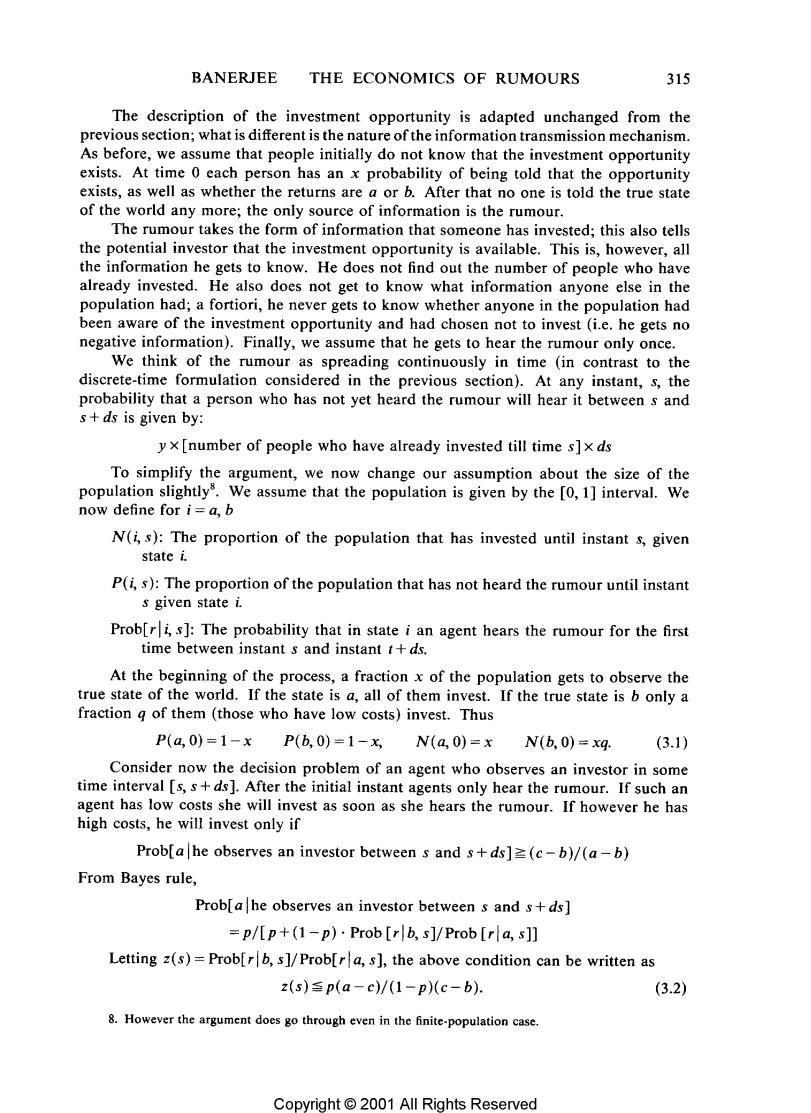正在加载图片...

BANERJEE THE ECONOMICS OF RUMOURS 315 The description of the investment opportunity is adapted unchanged from the previous section;what is different is the nature of the information transmission mechanism. As before,we assume that people initially do not know that the investment opportunity exists.At time 0 each person has an x probability of being told that the opportunity exists,as well as whether the returns are a or b.After that no one is told the true state of the world any more;the only source of information is the rumour. The rumour takes the form of information that someone has invested;this also tells the potential investor that the investment opportunity is available.This is,however,all the information he gets to know.He does not find out the number of people who have already invested.He also does not get to know what information anyone else in the population had;a fortiori,he never gets to know whether anyone in the population had been aware of the investment opportunity and had chosen not to invest(i.e.he gets no negative information).Finally,we assume that he gets to hear the rumour only once. We think of the rumour as spreading continuously in time (in contrast to the discrete-time formulation considered in the previous section).At any instant,s,the probability that a person who has not yet heard the rumour will hear it between s and s+ds is given by: yx[number of people who have already invested till time s]x ds To simplify the argument,we now change our assumption about the size of the population slightly We assume that the population is given by the [0,1]interval.We now define for i=a,b N(i,s):The proportion of the population that has invested until instant s,given state i. P(i,s):The proportion of the population that has not heard the rumour until instant s given state i. Prob[ri,s]:The probability that in state i an agent hears the rumour for the first time between instant s and instant t+ds. At the beginning of the process,a fraction x of the population gets to observe the true state of the world.If the state is a,all of them invest.If the true state is b only a fraction g of them (those who have low costs)invest.Thus P(a,0)=1-xP(b,0)=1-x,N(a,0)=xN(b,0)=xg (3.1) Consider now the decision problem of an agent who observes an investor in some time interval [s,s+ds].After the initial instant agents only hear the rumour.If such an agent has low costs she will invest as soon as she hears the rumour.If however he has high costs,he will invest only if Prob[a he observes an investor between s and s+ds]=(c-b)/(a-b) From Bayes rule, Prob[ahe observes an investor between s and s+ds] p/[p+(1-p).Prob[r|b,s]/Prob [r a,s]] Letting z(s)=Prob[r b,s]/Prob[ra,s],the above condition can be written as z(s)=p(a-c)/(1-p)(c-b). (3.2) 8.However the argument does go through even in the finite-population case. Copyright 2001 All Rights Reserved